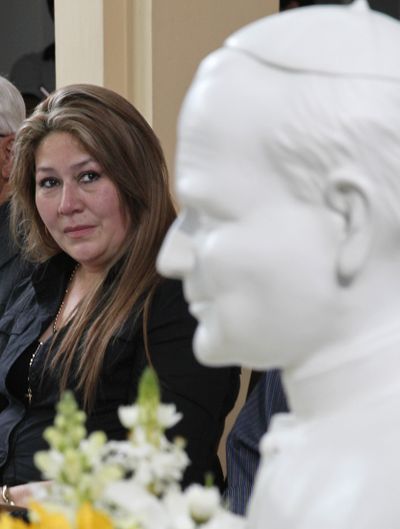Pope clears predecessors for sainthood
Cure of woman from Costa Rica deemed a miracle

VATICAN CITY – Pope Francis on Friday cleared two of the 20th century’s most influential popes to become saints, approving a miracle needed to canonize Pope John Paul II and waiving Vatican rules to honor Pope John XXIII.
It was a remarkable show of papal authority and confirmed Francis’ willingness to bend church tradition when it comes to things he cares deeply about.
Both popes are also closely identified with the Second Vatican Council, the 1962-65 meetings that brought the Catholic Church into modern times, an indication that Francis clearly wants to make a statement about the council’s role in shaping the church today.
Francis approved a decree that a Costa Rican woman’s inexplicable cure from a deadly brain aneurism was the “miracle” needed to canonize John Paul. The woman, Floribeth Mora, broke months of silence Firday to tell her story in public, surrounded by her family, doctors and church officials at a news conference in the archbishop’s residence in San Jose, Costa Rica.
More significantly, Francis decided that John XXIII, who convened Vatican II, could be declared a saint even without a second miracle attributed to his intercession. The Vatican said Francis had the power to dispense with such requirements and could proceed with only one confirmed miracle to John’s name.
The ceremony is expected before the end of the year. The date of Dec. 8 has been floated as likely, given it’s the feast of the Immaculate Conception, a major feast day for the church that honors Mary, to whom both saintly popes were particularly devoted. Polish prelates continue to press for October, to mark the 35th anniversary of the Polish-born John Paul’s election, but Vatican officials have suggested that’s too soon to organize such a massive event.
The announcement came on a remarkable day melding papacies past and present: It opened with Francis and Pope Emeritus Benedict XVI attending their first Vatican ceremony together, sitting side-by-side on matching papal chairs for the unveiling of a statue in the Vatican gardens. It continued with the publication of Francis’ first encyclical, a meditation on faith that was largely written by Benedict before he retired but was signed by Francis. And it climaxed with Francis’ decision to canonize two other predecessors.
Each event, historic on its own, would have captured headlines. But the canonization announcement capped them all, reflecting the priorities of this unique pontificate that has already broken so many rules and traditions, from Francis’ decision to shun papal vestments to his housing arrangements, living in the Vatican hotel rather than the stuffy Apostolic Palace.
The Rev. Thomas Reese, a Vatican analyst, said the decision to canonize both popes was a “brilliant move to unify the church,” given that each pope has his own admirers and critics.
“With the joint announcement, Pope Francis is saying we do not have to choose between popes, we can honor and revere both as holy men who served the church well in their times,” he wrote on his blog for the National Catholic Reporter newspaper.